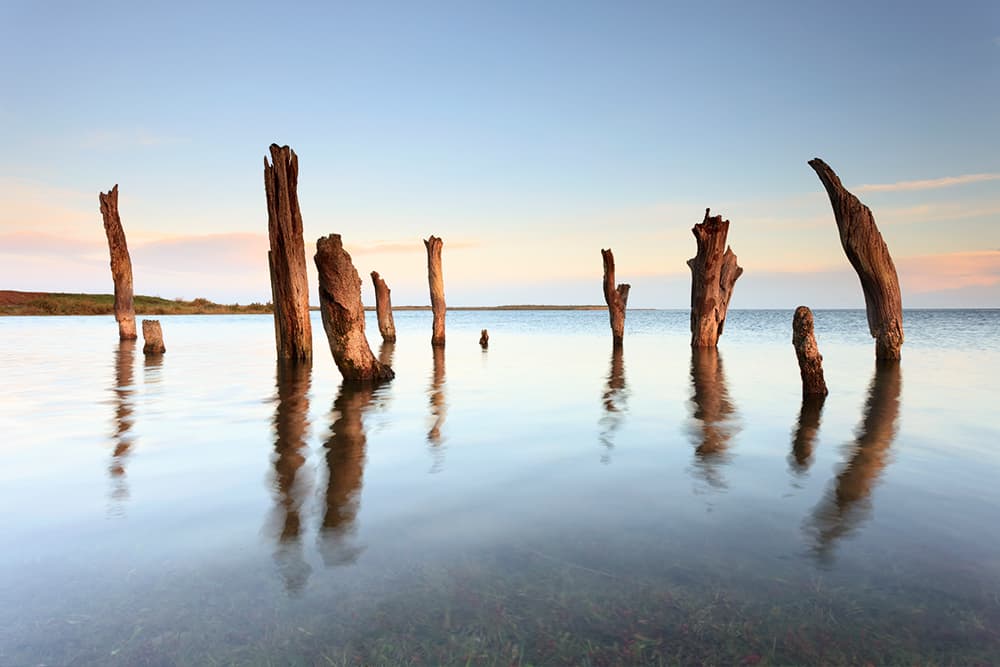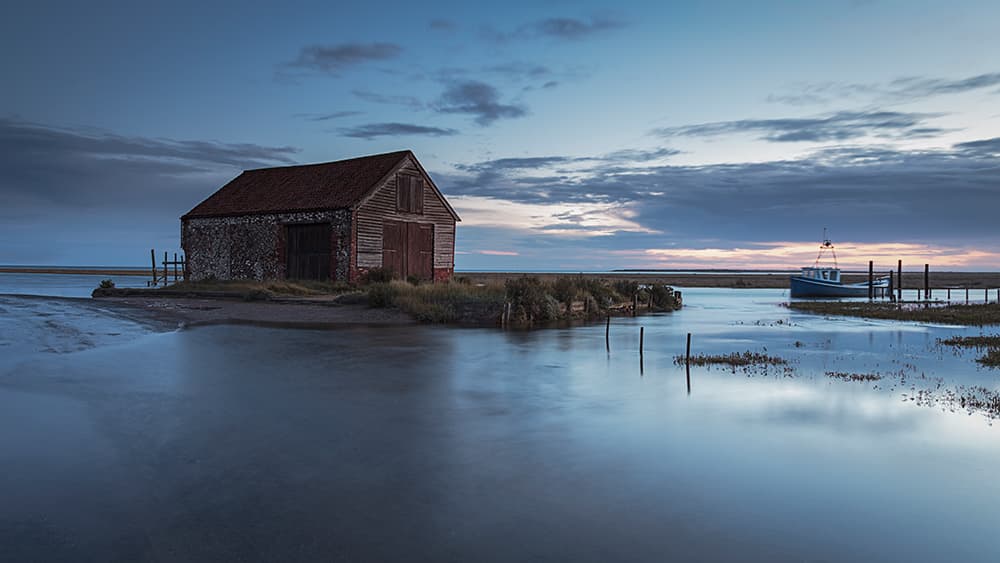
These wooden stumps rising out of the salt marsh make for an interesting composition. All photos by Justin Minns
The North Norfolk coast is a wonderful mix of endless sandy beaches fringed with windswept dunes, acres of wide-open salt marsh teeming with wildlife, picturesque harbours, fishing boats, flint cottages and, of course, big skies. Thornham is a small village on the edge of the salt marsh on the western end of the coast. It has a sleepy harbour that’s all but deserted, and features a photogenic coal barn and a scattering of boats moored along the creek that meanders its way from here across the marsh to the sea.
How to access Thornham in Norfolk
Part of the charm of the north Norfolk coast is its relative isolation. Thornham lies on the A149, which winds its way along the coastline all the way from King’s Lynn to Cromer. From the village, follow Staithe Lane to the small, free car park at the very end. It’s conveniently placed a few steps from the harbour. A ten-minute walk along the Norfolk Coast Path from here will take you out to the dunes and the beach. There are arguably better beaches to be found a few minutes’ drive east along the coast road, where you’ll find Brancaster’s huge sandy expanse. Five minutes in the other direction takes you to Hunstanton, with its distinctive striped cliffs and unusual rock formations. Both Brancaster and Hunstanton have large car parks within a short walk of the beaches.
It’s always a good idea to check the tides before visiting Thornham. During spring high tides, Staithe Lane floods, leaving the car park cut off until the water subsides. The same is true of the road to Brancaster beach and many other car parks along the coast, so be aware of this when you find a spot to park.

In summer, the setting sun brings the colours of the salt marsh alive
How to photograph Thornham
Thornham is an interesting place to shoot all year round. misty autumn scenes and frosty winter mornings have a lot of atmosphere, but the long, peaceful summer evenings are my favourite time to visit this part of the world.
The coast here faces north, so in summer the sun rises and sets over the sea, and the salt marsh comes alive with a haze of purple sea lavender and pink sea thrift that add a splash of colour to proceedings.
The coal barn makes an obvious photographic subject, but look closer and there’s much more to be found. the riverbank is lined with rickety jetties, where colourful old boats lie stranded in the mud at low tide.
The marsh is dotted with reflective pools and carved by twisting creeks that are spanned by makeshift bridges, all of which make for great foreground material – and are even interesting subjects in their own right. Just beyond the car park, a number of gnarled wooden stumps rise mysteriously from the salt marsh. During spring high tides, these are completely surrounded by water, further adding to their mystery.
More tips and locations:
[collection name=”small”]
Where to eat and stay in Thornham
This part of the Norfolk coast has plenty of places to stay. there are several holiday cottages and B&Bs in Thornham itself, while a wider choice of accommodation can be found in Hunstanton, which is only a five-minute drive away. Thornham has tea rooms, a deli café and three pubs, all of which offer both food and accommodation. the Lifeboat inn is a dog-friendly traditional pub serving locally sourced food and a good choice of beers.

The coal barn and small colourful fishing boats are excellent focal points
Photography kit for photographing Thornham
Tripod
In low light, a tripod is a must for ensuring sharp shots at low ISOs, but even more so if you’re working at low angles when it always seems harder to keep the horizon straight.
Filters
A set of ND graduated filters will help your camera cope with the high dynamic range when shooting around the hours of sunrise and sunset. A hard grad is ideal for the clear horizons here.
Wideangle lens
Although a standard zoom such as a 24-70mm is useful at Thornham, I find that a wide-angle lens gives you the option of getting closer and making more of any interesting foregrounds
Justin Minns is a professional landscape photographer specialising in atmospheric images of East Anglia, as well as running workshops in the region. www.justinminns.co.uk







